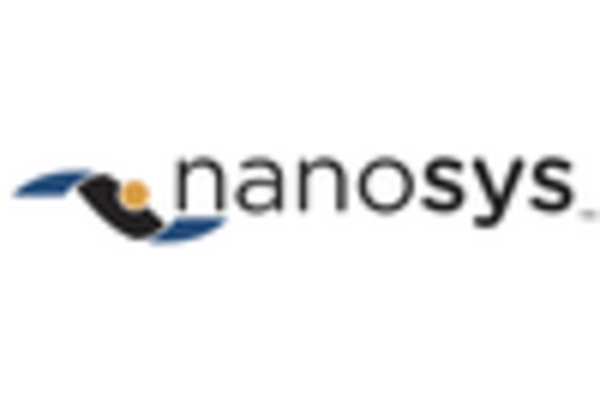Emergence of Smart Textiles
The Nano Compounds Market is benefiting from the emergence of smart textiles, which integrate nano technologies to enhance fabric performance. These textiles can offer functionalities such as moisture-wicking, stain resistance, and even embedded sensors for health monitoring. The Nano Compounds is anticipated to reach over 5 billion dollars by 2026, driven by consumer demand for innovative and functional clothing. This trend indicates a promising avenue for the Nano Compounds Market to develop and supply nano-enhanced materials that cater to the growing interest in wearable technology and performance apparel. As the market evolves, the integration of nano compounds in textiles is likely to become a key differentiator in the industry.
Growth in Energy Storage Solutions
The Nano Compounds Market is poised for growth due to the increasing demand for advanced energy storage solutions. With the rise of renewable energy sources, there is a pressing need for efficient batteries and supercapacitors that can store energy effectively. Nano compounds, such as carbon nanotubes and graphene, are being integrated into energy storage devices to enhance their performance, longevity, and charge capacity. Recent studies suggest that The Nano Compounds could reach a valuation of over 200 billion dollars by 2026, indicating a substantial opportunity for the Nano Compounds Market to contribute to this burgeoning sector. As energy storage technologies evolve, the demand for nano-enhanced materials is likely to escalate, positioning the industry favorably for future growth.
Rising Demand in Automotive Sector
The Nano Compounds Market is experiencing a notable surge in demand from the automotive sector. As manufacturers strive to enhance vehicle performance and fuel efficiency, the incorporation of nano compounds in materials such as coatings, tires, and batteries becomes increasingly prevalent. For instance, nano-enhanced materials can significantly reduce weight while maintaining structural integrity, leading to improved fuel economy. The automotive industry is projected to witness a compound annual growth rate of approximately 4.5 percent over the next few years, further driving the need for innovative materials. This trend indicates a robust opportunity for the Nano Compounds Market to expand its footprint in automotive applications, as companies seek to meet stringent environmental regulations and consumer expectations for sustainability.
Expansion in Construction Materials
The Nano Compounds Market is witnessing expansion due to the increasing application of nano materials in construction. As the construction industry seeks to improve the durability and sustainability of buildings, nano compounds are being utilized in concrete, paints, and insulation materials. These compounds can enhance properties such as strength, thermal resistance, and moisture control. The construction sector is projected to grow at a rate of approximately 5 percent annually, which could lead to a heightened demand for innovative materials. This growth presents a significant opportunity for the Nano Compounds Market to supply advanced solutions that meet the evolving needs of modern construction practices.
Innovations in Drug Delivery Systems
The Nano Compounds Market is significantly influenced by advancements in drug delivery systems. The pharmaceutical sector is increasingly adopting nano compounds to improve the efficacy and targeting of therapeutic agents. Nanoparticles can facilitate the delivery of drugs directly to affected cells, minimizing side effects and enhancing treatment outcomes. The global market for nanomedicine is expected to surpass 300 billion dollars by 2025, reflecting the growing reliance on nano technologies in healthcare. This trend underscores the potential for the Nano Compounds Market to play a crucial role in revolutionizing drug delivery methods, thereby improving patient care and treatment efficiency.

















Leave a Comment